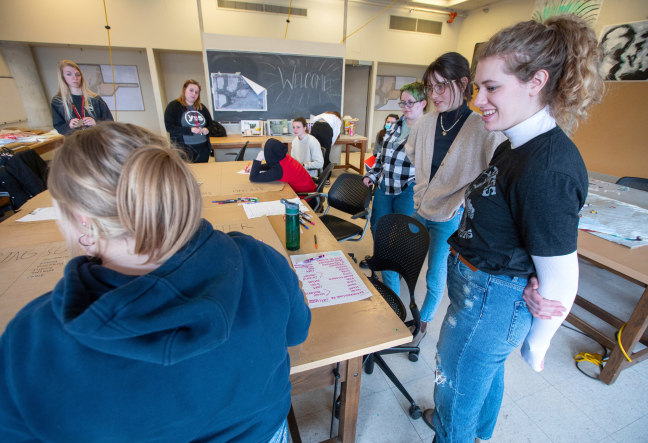
ISU design students, from right, Tara Tilstra, Jordyn Kloss and Rowan Anderson speak with YSS youth about the plot of land on which their new building will reside. Photos by Christopher Gannon. .
AMES, Iowa — An Iowa State University researcher is embarking on a new research path, paving the way in an emerging field of study within landscape architecture: trauma-informed environmental design.
Julie Stevens, associate professor of , is collaborating with YSS on its new Recovery Campus near Cambridge, on which they plan to break ground later this spring. YSS provides mental and behavioral health services for youth and their families in central Iowa.
During a recent meeting of the option studio, three groups of YSS youth headed to the College of Design to work with Stevens’ students. The children each wrote down their typical day at YSS, hour by hour. They then cut out each activity by the hour and pinned them to a map of the Cambridge property, showing where they would like to do each activity. Many of the girls, for example, wanted to be surrounded by nature for daily therapy.
“I chose this option studio because I love helping others and architecture should be of tangible benefit to people,” said Tara Tilstra, master’s student in architecture from Sioux Center.
This academic year, Stevens and her students are helping YSS with master planning and site planning for the new facility, all through participatory design with YSS children and staff, and the design team, RDG Planning & Design.
Participatory design is a process that Stevens says is too often understimated, overlooked or simply cut short in the design fields.
“I learned through that it takes a really long time to understand clients and their needs, especially when working with vulnerable people,” Stevens said. “A worthy participatory process necessitates putting the power of design into the hands of those who have the most to gain or lose from the resulting built environments — in this case, vulnerable and underserved youth.”
Proactive over reactive
The majority of the children in YSS that Stevens and her students are working with are in addiction recovery. YSS wanted to partner with Stevens because they want to use nature as the main driver for healing.
“YSS is so grateful for the commitment of Julie and her students who have dedicated countless hours to engage those we serve through authentic youth development – giving their perspective life,” said Andrew Allen, YSS president and chief executive officer. “They are helping bring to life our vision for a best-in-class nature-based behavioral health campus. This project is needed now more than ever as we’re experiencing a youth mental health and addiction crisis. Julie’s efforts will impact the lives of thousands of youth and young adults who will receive treatment at YSS.”
Stevens and her research collaborators are innovators in an emerging field: trauma-informed environmental design, in which designers work to understand their clients deeply and how their life experiences affect how they experience various environments today in order to better serve them in the design process. “Trauma-informed” should not be a buzzword in the design fields, Stevens says: “The physical environment says a lot about the value we place on those living, working and learning within them.”
“Human services have to be trauma-informed because we work with so many people who have experienced such extreme trauma and toxic stress,” she said. “We need to look at how the environment can hinder well-being as well as how it can improve well-being.”
More than 2 million youth ages 12-17 reported using drugs in the past month, according to the ³Ô¹ÏÍøÕ¾ Survey on Drug Use and Health. Over 500,000 youth experience homelessness every year, according to the ³Ô¹ÏÍøÕ¾ Alliance to End ³Ô¹ÏÍøÕ¾lessness.
These statistics are “heart-breaking,” Stevens says.
“I feel like as a society we could all work a little harder to take care of these kids early on, meet their needs, help them learn coping skills, relational skills and address the painful experiences that led them to substance use. I really think that if we could eliminate trauma, we would find ourselves in a world with no violence, no homelessness and no addiction. This may sound impossible to some, but do any of us really want to see more trauma in the world?”
Stevens will conduct research throughout her work with YSS, as well as post-occupancy evaluations to understand how youth experience the new environment, how their parents and caregivers feel and how YSS programs changed in effectiveness between facilities.
Stevens says the design field can be more proactive and advocate to create truly healing environments. Rather than fitting what is already done into a “trauma lens,” she urges designers to begin the design process by understanding trauma and using evidence-based research to inform design solutions, and taking the time to include clients throughout the process.
“I hope someday that trauma-informed environmental design will look similar to LEED certification, and ultimately be included in licensure requirements because mental health is part of human health, safety and welfare,” she said. “Anyone who’s working in schools, health care facilities, treatment facilities, youth settings, homeless facilities, veterans’ facilities, etc., need to understand how someone who has experienced trauma might experience the designed environment.”







